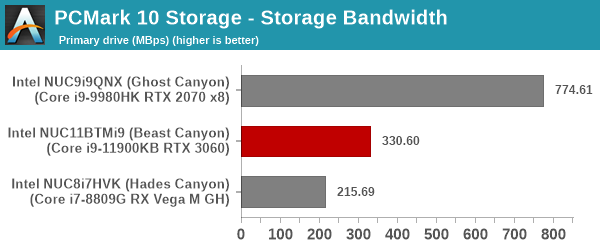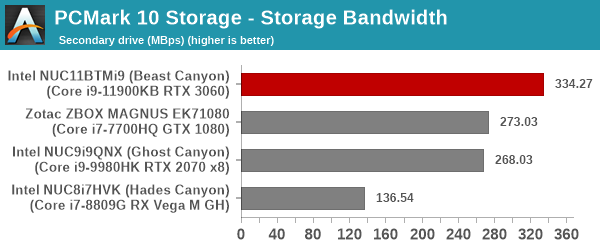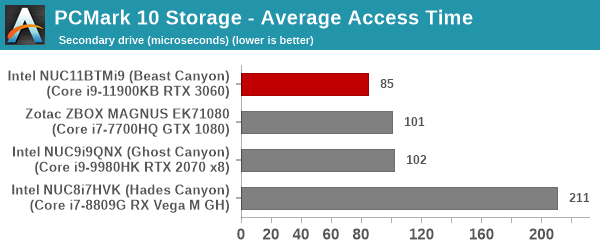Intel Beast Canyon NUC Review: Desktop Tiger Lake Debuts in SFF Gaming Powerhouse
by Ganesh T S on July 29, 2021 9:00 AM EST- Posted in
- Systems
- Intel
- NUC
- Tiger Lake
- NUC11
- Beast Canyon
Miscellaneous Aspects and Concluding Remarks
The storage subsystem in the Tiger Lake-based notebooks and PCs presents some interesting aspects. These are the first crop of SFF / battery-powered devices to sport direct CPU-attached PCIe Gen 4 capabilities. The PCMark 10 suite includes a storage benchmark suite. The Sabrent Rocket NVMe 4.0 (directly attached to the CPU) was subject to the 'Full System Drive Benchmark'. Note that there are two sets of graphs below, as we configure a primary and a secondary drive / partition for all evaluated systems. In the case of the Ghost Canyon NUC, the Optane drive was fully allocated as the primary partition. For the Beast Canyon NUC, the drive was partitioned into two - a 180GB OS partition, and a 285GB data partition.




Despite the PCIe 3.0 link, the direct-attached Optane drive in the Ghost Canyon is the top performer by a significant margin in terms of both bandwidth and average access time for real-world applications. In the secondary drive shootout between NAND flash-based SSDs, the PCIe 4.0 link helps the Sabrent Rocket NVMe 4.0 emerge as the leader.
The Beast Canyon NUC brings two important updates on the networking front. The Wi-Fi 6E capability enabled by the Intel AX210 allows wireless access over the 6GHz spectrum that is not subject to as much interference as the 5GHz and 2.4GHz ones. The wired side also receives a boost with 2.5G BASE-T support. The dual LAN capability present in the Ghost Canyon NUC has unfortunately been done away with. That said, the presence of Thunderbolt 4 ports with hub capabilities offers a lot of flexibility to end users. There are many Thunderbolt 4 docks and hubs in the market with such added features.
One of the aspects usually covered in detail in our SFF PC reviews relates to the usage of the system as a HTPC. Being a full-blow gaming desktop, it is unlikely for the Beast Canyon NUC to be used solely as a home-theater PC. The system manages to play back 4K content in multiple different codecs, and YouTube / Netflix UHD content play flawless without dropped frames. However, its noise profile and power consumption numbers do not make it effective or efficient for such tasks. We do plan to evaluate the HTPC capabilities of the Tiger Lake platform in a future piece (with one of the low-power NUCs). That said, if there is enough reader interest, we can do a similar analysis for the Ampere GPU in SFF systems such as the Beast Canyon NUC.
Closing Thoughts
Coming to the business end of the review, Intel's Beast Canyon NUC (NUC11BTMi9) is the latest and greatest performance-oriented mini-PC. The gaming market has been one of the primary drivers of growth in the PC space, and it is no surprise that the Beast Canyon NUC has its sights locked on to that segment. It is a worthy follow-up to last year's Ghost Canyon NUC. In particular, by putting in enough room for a 350W PCIe video card up to 12 inches in length while still retaining a small form factor, Intel has resolved a major issue that had prevented the NUCs from capturing a share of the gaming market. And the inclusion of features such as user-addressable RGB lighting (opinions may be divided on this, but RGB undoubtedly sells) make it all the more attractive for the gaming crowd.
Intel is not alone in trying to make SFF gaming systems attractive to consumers. OEMs like Zotac have been playing in this market for a few years now. The ZBOX E-series MAGNUS line of mini-PCs have slowly moved forward from MXM-type GPUs to full-blown discrete ones. The MAGNUS ONE announced at the 2021 CES has been shipping for a few months now. That system took cues from the Ghost Canyon NUC, but tweaked things enough to be able to accommodate a proper socketed Comet Lake desktop CPU. It doesn't come with premium features such as Thunderbolt 4 or 2.5G BASE-T support.
To that end, Intel would do well to adopt some of the aspects of the MAGNUS ONE such as a Type-C port in the front panel, avoiding of recessed ports, and a rear panel tuned for good cable management. The MAGNUS ONE also allows for tool-less disassembly to access the internals. The Ghost Canyon and Beast Canyon chassis designs are overly complicated when compared to Zotac's.

From L to R: Beast Canyon, Ghost Canyon, Zotac ZBOX MAGNUS ONE
The default BIOS configuration used for evaluating the Beast Canyon put it in the maximum performance mode. The PL1 and PL2 values were set for 65W and 109W. In terms of load and idle power consumption, there is not much to differentiate between the Ghost Canyon NUC and the Beast Canyon NUC. However, the benchmark numbers show a clear advantage for the Tiger Lake-enabled Beast Canyon. The BIOS could do with some tweaks to alter the fan curves for better thermals, while also trying to minimize the noise profile.
Overall, the 65W TDP Compute Element is a winner in terms of providing an ideal platform for a SFF gaming desktop that is powerful, yet power-efficient. The Monster Cove baseboard, though, leaves a bit on the table. The change in the location of the non-M.2 PCIe x4 slot and the need to use an air guide for the Compute Element may cause issues in certain use-cases that require and utilize a x8/x4/x4 PCIe bifurcation configuration. Moving the M.2 22110 slot to the underside is worth appreciating, though.
As for the Beast Canyon chassis, the build and appearance are suitable for the target market. Compared to other designs, third-party cases for the Driver Bay Compute Elements such as Akasa's Cypher HDB adopt different tradeoffs in terms of size, shape, and weight. They can cater to niches where the Beast Canyon chassis might not be entirely suitable or preferable.
Overall, Intel has been slowly building up a robust ecosystem around the Compute Elements, and with the focus on the gaming market, they should be able to reach economies of scale easily to drive their vision further. One of the complaints about the Ghost Canyon NUC was the pricing aspect. The NUC9i9QNX launched in July 2020 at $1700. The NUC11BTMi9 carries a much more palatable $1350 price tag. The NUC11BTMi7 is expected to be priced at $1150. The Compute Elements themselves are in the $780 - $980 price bracket. Availability of the Tiger Lake NUCs has been a major concern this year. Intel expects the Beast Canyon NUCs to start selling this quarter with broader availability during the holiday season.











84 Comments
View All Comments
vol.2 - Tuesday, August 3, 2021 - link
SFF = SMALL form factorIntel's marketing literature was pretty specific about it. Sure, they can change what NUC means by turning into a generic smallish PC device similar to Micro ATX, but that genericizes the NUC to the point where it just becomes Intel's brand for a form factor that already exists.
mode_13h - Wednesday, August 4, 2021 - link
> but that genericizes the NUC to the point where it just becomes Intel's brandYes, Intel is a pro at taking a naming scheme that has some logic to it, and then twisting it into something meaningless. Like, the i3/i5/i7 naming scheme, for instance. On some of their laptop chips, like the U-series Skylakes, they had exactly the same core-count and thread-count, differing only in a few hundred MHz of clock speed.
Hey, if marketing simply came up with a logical naming scheme and sticking to it, how would they "add value"? Marketing is always looking for a way to gin up sales, in the next quarter or FY.
mode_13h - Wednesday, August 4, 2021 - link
Remember, we're talking about the same Intel that changed their Xeon processors from using the E3/E5/E7 naming scheme to E/W/Silver/Gold/Platinum, back in 2017!mode_13h - Sunday, August 1, 2021 - link
> Intel are clearly moving the goalposts here on what a NUC form factor should beSo far, the lineup is:
* NUC Essential
* NUC
* NUC Pro
* NUC Extreme
I expect further up-range models will be:
* NUC Insane - HEDT CPU + dual GPU + water cooling
* NUC Ridiculous - dual CPU + quad-GPU + external radiator
willis936 - Thursday, July 29, 2021 - link
Now make it with ECC :)Jorgp2 - Thursday, July 29, 2021 - link
Buy one with ECCwillis936 - Thursday, July 29, 2021 - link
I would if the chipsets of CPUs from anytime in the past two years were available.AdrianBc - Thursday, July 29, 2021 - link
The previous Ghost Canyon had a variant with a mobile Xeon and ECC memory.It was very nice, except for 2 problems.
It was introduced one year too late, when Coffee Lake Refresh was already too obsolete and it was overpriced by about $500 compared with a standard desktop with similar features.
For this one, no version with a Xeon has been announced and there were no rumors about such a version.
dullard - Thursday, July 29, 2021 - link
I'm curious what niche use case needs a moderately small computer, but not too small, with video card, and ECC.AdrianBc - Thursday, July 29, 2021 - link
There are people like myself, who do not accept to use a computer without ECC in any circumstance. So, except for my mobile phone, I do not use any computer without ECC, neither as a laptop, nor as a desktop nor as a SFF computer and of course not as a server.Any computer without ECC is just a toy, guaranteed to have errors from time to time, which should be used only in game consoles or similar applications.
The fact that the computers without ECC are not a small niche is sad and this just shows how many people are so gullible that they will believe whatever a vendor says that is good for them.